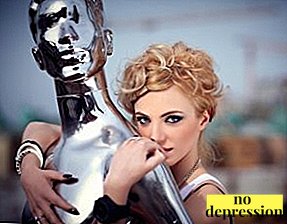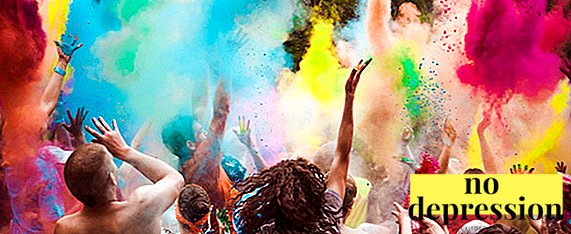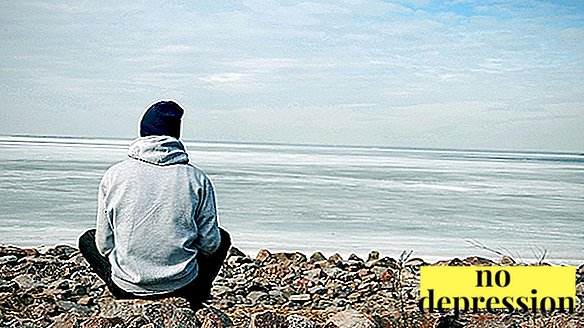For many people, the diagnosis of "autism" sounds like a sentence.
This is due to the lack of reliable information about this disorder, although in recent years the number of special children has increased several times.
In Russia no accurate data on these patients, as many children simply do not make such a diagnosis. Parents of special children should be aware of what autism is in adults and children and what are its signs.
What it is?

What is this disease? Autism - mental disorder, which is a consequence of abnormal development of the brain and expressed in the absence of human interaction with the outside world.
Such a child has a limited range of interests and activities.
Symptoms usually occur in children under 3, signs can be noticed at an early ageif you carefully watch the baby.
The exact causes of the disease has not yet been established. It has been proven that with this disease, several altered areas are found in the brain, but the mechanism of appearance is unknown.
Doctors call genetic theory as the main one: for unclear reasons, gene mutations occur. Another hypothesis is the impact of external factors causing impaired intrauterine development.
The theory of the relationship between autism and vaccination has not been confirmed. It is just that in some children the time of vaccination coincides with the manifestation of the disease.
Autism is considered an incurable pathology. With early diagnosis possible help the child adapt a little to the social environmentalthough only a few manage to learn how to live independently.
There is still a search for a cure for this problem, some people tend to consider it just a special condition, not a disease.
Types of disease
The International Classification of Diseases identifies the following types of autism:
- Canner syndrome (childhood autism). He was described by the psychologist Leo Canner. This form of the disease is diagnosed at the age of 1.5 years. The child has a lot of fears, there is no sense of self-preservation, the desire to visually contact with others. In addition, these children do not feel hunger and thirst, have violations in the cognitive and intellectual spheres.
- Atypical autism. It is possible to diagnose it only after 7 years, so the pathology is called adult autism. Patients are distinguished by problems with speech, thinking, and motor abilities.
- Asperger syndrome. Also refers to the early form, mainly diagnosed in boys up to 2 years. Patients lack abstract thinking, intellectual development is lagging behind, there are problems with social communication.
With early treatment it is possible to correct the pathology and such a child has the opportunity to study in a regular school.
- Rett syndrome. This is the most difficult and severe type of disease. It occurs in girls and does not respond to any treatment. In addition to mental disorders, physical development lags behind in patients. This is reflected in the disproportionate growth of body parts, curvature of the spine, etc.
- Nonverbal learning disorder syndrome. Patients are not able to learn how to write, read, nor have imaginative thinking, there is stereotyped behavior, poor memory. They are not able to communicate with peers.
- Semanto-pragmatic type of disease. Manifested by a delay in speech development and speech understanding. The patient can not remember the text, does not understand the metaphors, jokes, hidden subtext.

Stages of the disease

Classification of pathology (according to Nikolskaya) divides the disease by severity and is used to distinguish the stages of childhood autism in order to develop remedial measures:
- Disease 1 group. Patients are completely detached from the world, they lack visual contact and speech. They reject any communication, do not even respond to parents.
- Disease 2 groups. Such children are more active than children from group 1. Usually they communicate with a limited number of people, for example, with their parents. They are hard on the change of the situation, they show it with excessive emotions. The main reaction is aggression and auto-aggression. Patients can cause physical damage.
However, these children are much more adaptable to the outside world than the first group.
- Disease 3 groups. Patients are characterized by care in the inner world. They are busy with their business, fantasies. They perceive any intervention aggressively and emotionally. True, their hobbies are monotonous and stereotypical. For example, a child can constantly draw one item, play the same game.
- Disease 4 groups. These children expressed a slight backwardness of emotional development. They exhibit lethargy, stereotyped behavior, vulnerability and fatigue, very sensitive to any criticism or comments.
Autism Spectrum Disorders
Autism Spectrum Disorders (atypical autism) differ from autism by lighter manifestations. This group includes disorders that have one autistic symptom, for example, fear of eye contact.
Different patients may have different combinations of symptoms, because of which sometimes there are difficulties with the diagnosis.
Doctors identify the following symptoms of atypical autism:
- speech disorders;
- emotional failure;
- problems with social interaction and adaptation in society;
- lack of thinking;
- pathological emotionality.

Speech disorders expressed in the difficulties of learning the language, a small vocabulary, the stereotype of speech expressions. Such people are not able to empathize and express emotions.
Problems with social adaptation are manifested:
- desire for solitude;
- problems with establishing contacts with others;
- inability to make friends;
- avoiding eye contact with the interlocutor.
These patients have limited thinking. Changing the usual situation causes their fear, panic. They are unnecessarily tied to objects, clothing, toys.
Abnormal irritability constantly accompanies autists. They react to external minor irritants by heightened aggression and panic.
When does it occur?
The first signs of the disease appear children 6-18 months. Before that, they are no different from other children. By the age of 12 months, most parents notice some oddities in the baby’s behavior; at 1.5 years of age, developmental disabilities are already apparent.
How to determine? Symptoms that should alert parents:
- At 1 year old, the child is not trying to talk.
- He has no gesticulation (does not indicate the object, does not clap his hands, etc.).
- At the age of 1.5, he does not utter a single word.
- In 2 years does not speak in simple sentences.
- The baby has repetitive movements.
- The child avoids contact with people.

What is expressed?
Autists have certain symptoms of pathology. They may vary, so put diagnosis is possible only after a full examination. The disease is characterized by the presence of three signs (autistic triad):
- lack of social communication;
- problems in mutual communication;
- limited interests and stereotypical behavior.
Typical signs of autism:
- When talking, he tries not to look into his eyes.
- Does not seek to communicate with others, prefers to be alone.
- Nervous because of any touch.
- Overly sensitive to loud sounds and bright light.
- Can not articulate their thoughts.
- Shows excessive activity or passivity.
- Does not have a sense of self-preservation. For example, crossing the road in front of the car, grabbing hot objects, trying to jump from a great height.
- Constantly feels a sense of fear.
A characteristic feature of the pathology is stereotype behavior. Stereotypes are motor, sensory, speech and behavioral.
Motive | Sensory | Speech | Behavioral |
Monotonous movements. Jumping in one place. Long swing on the swing. | Rustling candy wrappers. Sniffing the same items. Constant squeezing in the hands of one toy. | Duplicate phrases. Recount items. Repeat sounds. | Selection of the same items of clothing. Walking along the same route. Adherence to one meal. |
Features of intellectual development are manifested in two variations:
- Lag in development. The patient can not concentrate on something, quickly gets tired, does not perceive the information.
- Advance in the development of narrow areas. Such patients show interest in narrow areas, sometimes ahead of their peers in certain areas. Also distinguished by a unique visual or auditory memory.
How do autists see the world?

Sick child usually does not distinguish between animate and inanimate objects.
Man for him is not a single whole, but a set of separate parts.
Also baby cannot trace the connection between events. External stimuli (sound, light, touch) are hostile to him, so he overreacts to them emotionally and tries to hide.
Symptoms
The clinical picture of the disease for each age is manifested by certain signs.
In newborns and children up to a year:
- Slow growth of individual parts of the body.
- Muscle weakness
- Lack of interest in bright objects, toys.
- No reaction to the parents.
- The scarcity of facial expressions.
- The emergence of stereotypical movements (swinging, flexing the arms, etc.).
In children from 3 years:
- Delayed speech development or the complete absence of speech.
- Occupation in a particular lesson. For example, a child can spend hours rolling one machine, build a house of cubes.
- The frequent appearance of fears. Children are afraid of changing their surroundings, communicating with others, and external irritants.
- Lack of perception of toys as a whole subject. For example, a child is interested only in a certain part of the machine.
- Reluctance to contact other children. Any attempts to establish contact end in crying or aggression.
- Abnormal aggression. In a stressful situation, the patient shows aggression not only to others, but also to himself.
- Convulsive seizures or convulsions may occur.
- Sleep disturbance Children often wake up screaming and cannot fall asleep again.
Teenagers:
- Incomplete speech, the inability to express your thoughts.
- The desire to be alone.
- Ritual behavior. A teenager performs the same actions every day, for example, he shifts his things.
- Adherence to certain foods.
- Limited behavior The patient watches only one program, plays one game.
- Unreasonable flashes of aggression. They occur when someone tries to disrupt the existing structure of the patient.
- Problems concentrating. The student may not concentrate on the lesson, but may concentrate on the details that interest him.
- Unusual abilities, or "island of genius." Some children show extraordinary talents in one area or demonstrate deep knowledge of a narrow focus.
- Eating pathology. They are very selective in their choice of dishes, they often make a demonstrative refusal to eat.

Adult disease

Symptoms of the disease in adulthood weaken somewhat, especially with early correction.
Autistic behavior of the patient depends on the level of social adaptation and acquired skills.
The person experiences the greatest difficulties in his personal life. They rarely manage to start a family, make friends. Thanks to the development of the Internet, autists have more opportunities to meet and start communicating with their own kind.
Men form a stereotype of sexual behavior on films. Excessive pushiness scares women. These men do not know how to care, They see no reason to give generally accepted attention to women.
Autistic women are usually very naive. They copy the behavior of movie characters. Because of their naivety, they are often sexually abused.
Most sick can live independently and serve themselvesespecially if they were treated as children. But some still need help.
If a patient has a well-developed intellect, then some types of remote work are available. Such patients excel in areas where focus on detail is required. Normal teamwork for autists is not suitable..
How to recognize the patient?
Surrounding people, faced with a strange human behavior, can not always understand the cause of these deviations. Often, strangeness is perceived as impolite, selfish, indifference.
Photo of a woman with autism:

Recognize the patient by the following signs:
- The person in conversation tries not to look into the eyes of the interlocutor.
- He does not show affection or emotional reaction.
- A person is fixated on one topic or lesson. His range of interests is very limited.
- He lives alone, does not communicate with neighbors, has no friends.
- His day is on the same schedule.
- It reacts inadequately to loud noises or bright light.
- Any encroachment on his space causes him an attack of aggression.
Autism - It is an incurable and not fully understood disease. Its prognosis depends on the form and stage of the pathology. If, in early childhood, to conduct the appropriate corrective therapy, the patient will increase the chances of a normal life and even professional activities.
The main signs of autism in this video are:



